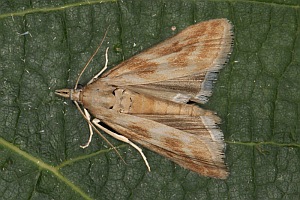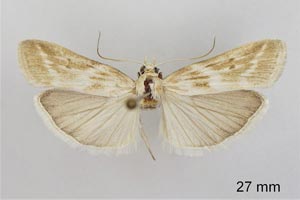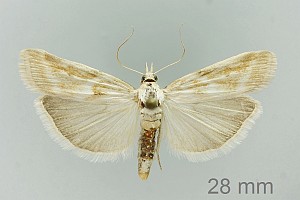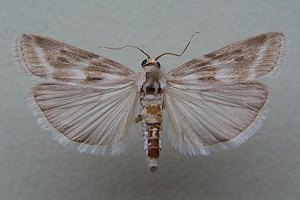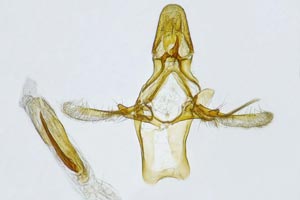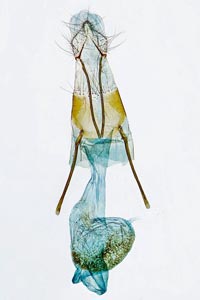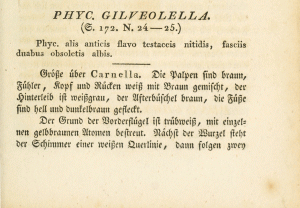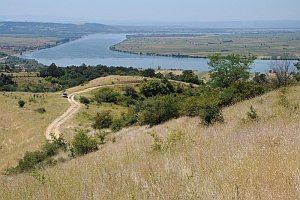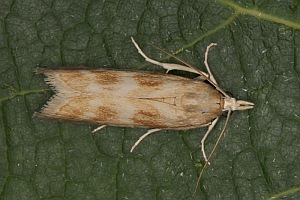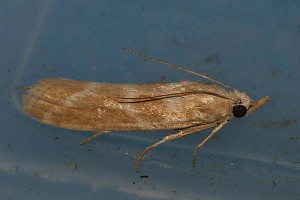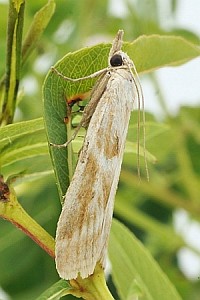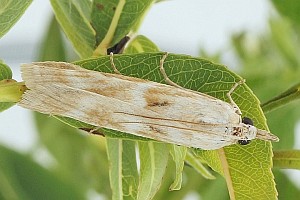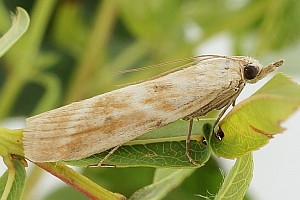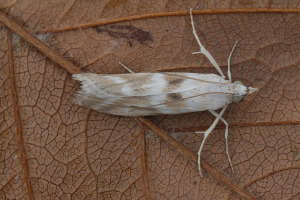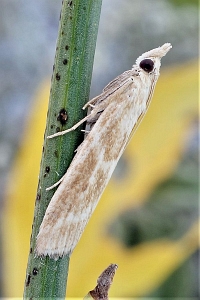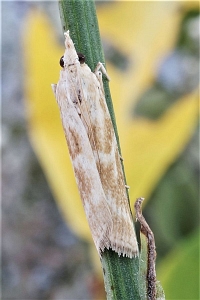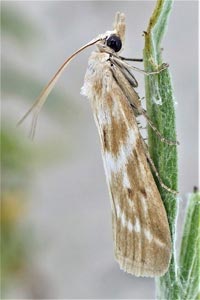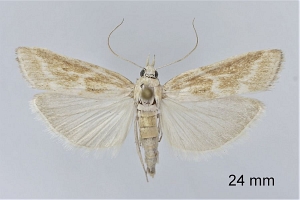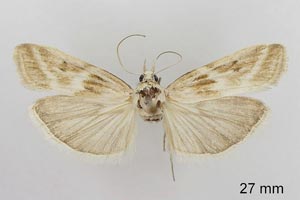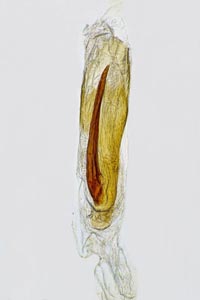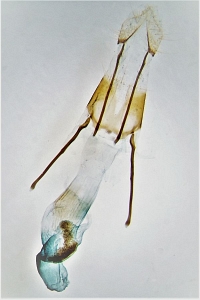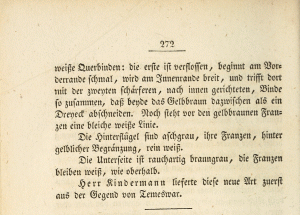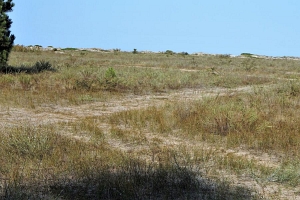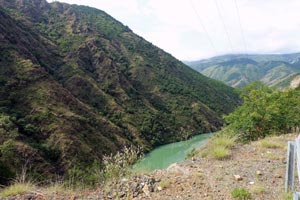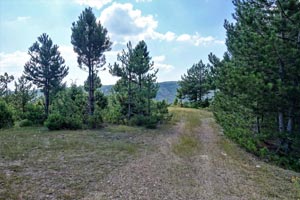

 +18Kontinente:EUAS
+18Kontinente:EUAS1. Lebendfotos
1.1. Falter
2. Diagnose
2.1. Männchen
2.2. Weibchen
2.3. Geschlecht nicht bestimmt
2.4. Genitalien
2.4.1. Männchen
2.4.2. Weibchen
2.5. Erstbeschreibung
3. Biologie
3.1. Habitat
3.2. Nahrung der Raupe
- [Asteraceae:] Chondrilla juncea (Großer Knorpellattich) [in Europa sicher mit großem Abstand wichtigste Nahrungspflanze]
- [Asteraceae:] Chondrilla ambigua
- [Asteraceae:] Chondrilla latifolia
- [Asteraceae:] Chondrilla brevirostris
- [Asteraceae:] Chondrilla pauciflora
- [Asteraceae:] Chondrilla kusnezovii
- [Asteraceae:] Chondrilla mujunkumensis
- [Asteraceae:] Chondrilla acantholepis
- [Asteraceae:] Chondrilla ramosissima
- [Asteraceae:] Taraxacum sp. ??? (Löwenzahn ???) [nur ausnahmsweise in der Zucht]
Die Raupe lebt - sehr oligophag - an Chondrilla juncea und anderen Arten der Gattung. Selbst in der Zucht werden andere Korbblütler praktisch vollständig abgelehnt.
In der Datenbank "HOSTS" (Robinson, G. S., P. R. Ackery, I. J. Kitching, G. W. Beccaloni & L. M. Hernández, 2010. HOSTS - A Database of the World's Lepidopteran Hostplants. Natural History Museum, London. [http://www.nhm.ac.uk/hosts]. (Accessed: 25 April 2018)) [HOSTS] werden mehrfach der Knorpelsalat Chondrilla juncea (für "Mediterranean", "Old World" und "Australia"), je einmal Chondrilla ambigua ("Old World") und Taraxacum ("Old World") angeführt.
Recht detaillierte Angaben zur Lebensweise finden sich auf der Artseite des Government of British Columbia, Ministry of Forests, Lands and Natural Resource Operations [for.gov.bc.ca]. Die Zuchtbeobachtungen an der Invasivpflanze Chondrilla juncea in Nordamerika führten zur Beschreibung "... Newly hatched larvae descend downward from the host plant by a silk thread and crawl over the soil surface to a plant. Once in contact with the plant, they begin to feed into the stem base then move downward and attach themselves to the root. The larvae continue to develop within loosely spun silk feeding tubes. Generally there are one or two larvae/root, but as many as three to 10 can be found. When mature, the larvae will measure 20-26mm with a 1.6-2.6mm wide head capsule. The pupae develop below the soil surface within the feeding tubes. Pupae are light-brown with a smooth appearance. Once pupation is complete, the emerging adults use the feeding tube to exit the root." Die Effektivität fes Falters für eine Bekämpfung der Pflanze ergab: "Larvae feed on rootstock and dissect sections of the root which interrupts the flow of nutrients and reduces the plants' root reserves. The larvae feeding also can destroy adventitious buds near the root crown. The feeding reduces plant vigour, reproductive ability and can kill small plants. The damage to larger plants causes them to be susceptible to pathogenic fungi. Large plants can survive minor attack, but heavily infested plants can be killed." Für Australien wurden gemäß dieser Quelle an Stellen mit Freilassung des Falters bis zu 60 % weniger Blütenansatz registriert.
Noch detaillierter bezüglich der Raupennahrung wurde das Environmental Assessment der usda.gov. (2002) [PDF auf aphis.usda.gov]. Dort heißt es zur Freiland-Raupennahrung: "Under field conditions, B. gilveolella has only been found to infest other Chondrilla species (L’Homme 1935, Caresche and Wapshere 1975). It is found on C. juncea, C. juncea form intybacea (= C. latifolia), C. brevirostris, C. ambigua, C. kossinskyi, (= C.pauciflora), C. kusnezovii and C. mujunkumensis in southern Russia (Sakharov 1930, Kozulina and Rudakova 1932, Dirsch 1933). Caresche and Wapshere (1975) found B. gilveolella on C. juncea, C. juncea form acantholepis (= C. acantholepis) and C. ramosissima in Greece."
Kashefi et al. (2008) berichten über "Field studies of the biology of the moth Bradyrrhoa gilveolella (Treitschke) (Lepidoptera: Pyralidae) as a potential biocontrol agent for Chondrilla juncea", wozu sie die Raupe auch detailliert vor Ort am Prespa-See in Nord-Griechenland, wo Chondrilla juncea besonders in Seenähe stark besiedelt wird.
(Autor: Erwin Rennwald)
4. Weitere Informationen
4.1. Etymologie (Namenserklärung)
„gilveolus gelblich.“
4.2. Andere Kombinationen
- Phycis gilveolella Treitschke, 1833 [Originalkombination]
4.3. Faunistik
Bassi et al. (2025: 195) melden die Art erstmals für das italienische Festland (Piemonte, Vernante (CN), Palanfré, 1400 m) und vermerken dazu, dass es für die alten Angaben von Sizilien keine neue Bestätigung mehr gibt.
(Autor: Erwin Rennwald)
4.4. Literatur
- Bassi, G., Graf, F. & F. Slamka (2025): New or interesting Pyraloidea for the European and Italian faunas (Insecta: Lepidoptera). — SHILAP Revista de lepidopterología, 53 (209): 189-201. [zum PDF-Download auf shilap.org]
- Environmental Assessment (2002): Field Release of Bradyrrhoa gilveolella (Lepidoptera: Pyralidae), for Biological Control of Rush Skeletonweed, Chondrilla juncea (Asteraceae). - 16 S.; [PDF auf aphis.usda.gov]
- Kashefi, J., Markin, G.P. & J.L. Littlefield (2008): Field studies of the biology of the moth Bradyrrhoa gilveolella (Treitschke) (Lepidoptera: Pyralidae) as a potential biocontrol agent for Chondrilla juncea. - 568-572. XII. International Symposium on Biological Control of Weeds. [PDF auf invasive.org/proceedings]
- Erstbeschreibung: Treitschke, F. (1833): Die Schmetterlinge von Europa 9 (2): 1-294. Leipzig (Ernst Fleischer).
- Yepishin, V., Khalaim, Y. & S. Novytskyi (2024): The Pyraloidea of the Odesa region of Ukraine (Insecta: Lepidoptera). — SHILAP Revista de lepidopterología 52 (205): 115-141. [PDF auf shilap.org]
















